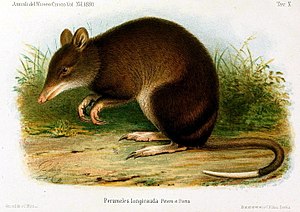New Guinea nasal purse
| New Guinea nasal purse | ||||||||||||
|---|---|---|---|---|---|---|---|---|---|---|---|---|

Long-tailed mouse nasal sac ( Microperoryctes longicauda ) |
||||||||||||
| Systematics | ||||||||||||
|
||||||||||||
| Scientific name | ||||||||||||
| Echymiperinae | ||||||||||||
| McKenna & Bell , 1997 |
The New Guinea nasal pucks (Echymiperinae) are a subfamily of the order of the nasal pucks (Peramelemorphia). Around 10 species in three genera are included in this family.
distribution
As the name suggests, New Guinea nosebags live mainly on the island of New Guinea and on offshore islands such as the Bismarck Archipelago , as well as on the Moluccas ( Seram Island ). One species is also found on the Cape York Peninsula on the northern tip of Australia .
description
In many aspects, the New Guinea nosebags represent the order of the nosebags, for example in the long, pointed snout, the longer hind legs and the forefeet used for digging. However, they differ more in terms of size. While some mouse nasal sacs reach a body length of only 15 to 18 cm, the large New Guinea nasal sacs are up to 55 cm long and weigh almost 5 kg.
Way of life
In contrast to the Australian nosebags , the New Guinea nosebags prefer tropical rainforests up to an altitude of 4500 m as their habitat. They are loners who meet their same-sex conspecifics with aggression. During the day they retreat in piles of leaves, hollow tree trunks or shallow burrows, and at night they look for food.
food
New Guinea nosebags feed on both fruits and insects, their larvae and small vertebrates, they are omnivores.
Reproduction
Little is known about the reproduction of the New Guinea nasal aspirators. In most respects they should be the same as the Australian nasal purse.
Systematics
The system of nasal aspirators is not undisputed. Since the New Guinea nosebags are more closely related to the Australian nosebags than with pig's foot and rabbit nosebags, they are grouped together with the Australian species as actual nosebags . The main differences to these lie in the shape of the skull (cylindrical in contrast to the flattened skulls of the Australian species) and in the habitat.
Genera
- The sting bandicoot ( Echymipera ) are distinguished primarily by their hard, spiky fur
- The smallest nasal sacs belong to the mouse nasal sacs ( Microperoryctes ).
- The Ceram nasal bag ( Rhynchomeles prattorum ) occurs only on the Moluccan island of Seram . It has not been sighted since 1920 and may have been extinct.
literature
- Ronald M. Nowak: Walker's Mammals of the World . Johns Hopkins University Press, 1999 ISBN 0-8018-5789-9
- Wilson, DE, and DM Reeder: Mammal Species of the World . Johns Hopkins University Press, 2005. ISBN 0-8018-8221-4
Individual evidence
- ↑ Christopher Dickman: Family Peramelidae (Bandicoots and Echymiperas). in Don E. Wilson , Russell A. Mittermeier : Handbook of the Mammals of the World - Volume 5. Monotremes and Marsupials. Lynx Editions, 2015, ISBN 978-84-96553-99-6 , pages 362-363.